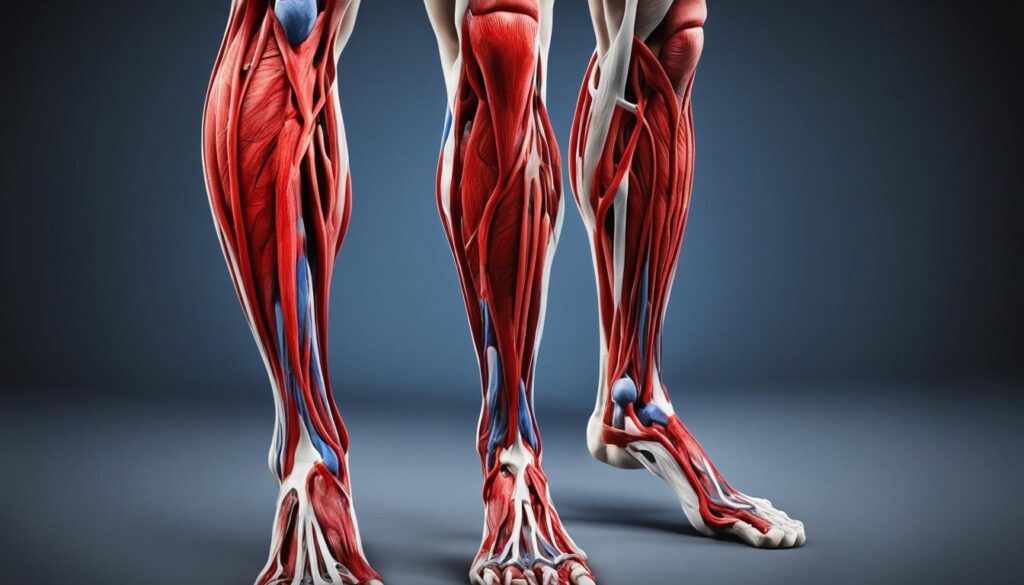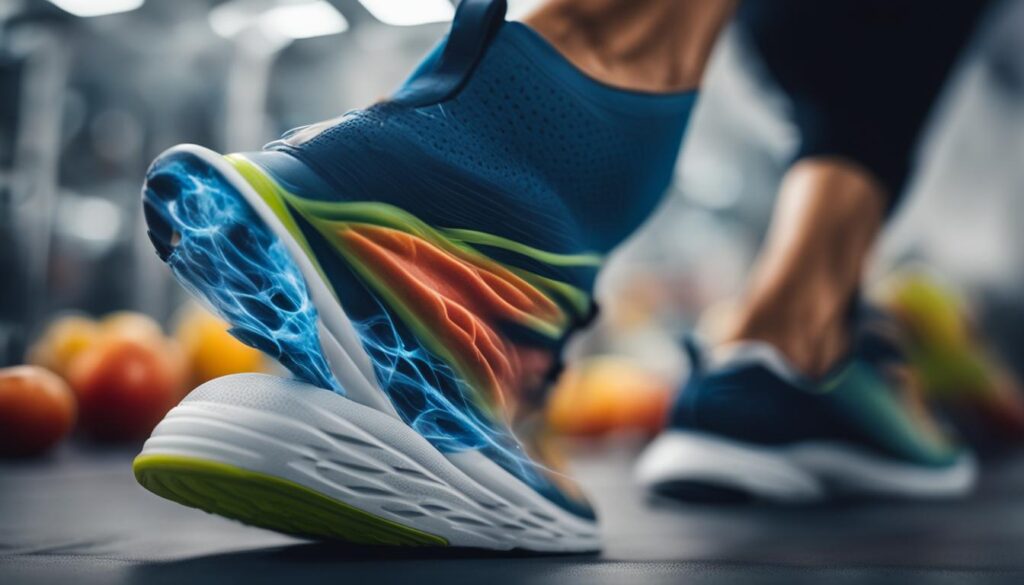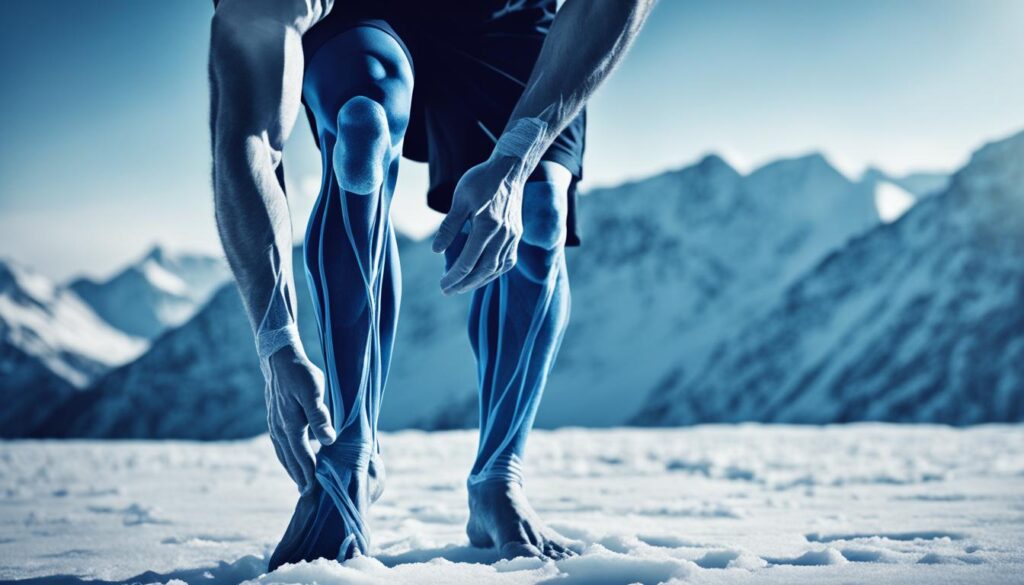Are you experiencing leg cramps and wondering if poor circulation could be the culprit? It’s not uncommon for poor circulation to lead to leg cramps, as reduced blood flow and oxygen can affect the muscles in your legs and feet.
Vein disease, such as venous insufficiency, is a common cause of poor circulation. This occurs when the valves in your veins become damaged and don’t function properly, leading to decreased blood flow. Now, you may be wondering, what are the symptoms of poor circulation?
Symptoms of poor circulation include cold feet or legs, swollen legs or feet, muscle cramping, numbness, changes in skin color, venous ulcers, and varicose veins. If you’re experiencing any of these symptoms, it’s important to seek medical evaluation to determine the underlying cause and receive the appropriate treatment.
Key Takeaways:
- Poor circulation can cause leg cramps due to reduced blood flow and oxygen to the muscles in your legs and feet.
- Vein disease, such as venous insufficiency, is a common cause of poor circulation.
- Symptoms of poor circulation include cold feet or legs, swollen legs or feet, muscle cramping, numbness, changes in skin color, venous ulcers, and varicose veins.
- Seek medical evaluation to determine the underlying cause and receive appropriate treatment if you’re experiencing symptoms of poor circulation.
- Addressing the underlying circulation issues through lifestyle changes, compression stockings, minimally invasive vein treatments, or surgery can help treat leg cramps caused by poor circulation.
The Link Between Leg Cramps and Poor Circulation
Leg cramps can be a result of poor circulation, specifically due to reduced blood flow and oxygen to the legs and feet. Vein disease, such as venous insufficiency, is a common cause of poor circulation and can lead to muscle cramping. When blood flow is inconsistent, the muscles may not receive enough oxygen, causing cramps, aches, and pains. It is important to address the underlying poor circulation to alleviate leg cramps and improve overall leg health.
Causes of Poor Circulation in Legs
There are several factors that can contribute to poor circulation in the legs. Understanding these causes is essential for appropriate diagnosis and treatment. The main contributors to poor circulation in the legs include vein disease, blood clots, and May-Thurner Syndrome.
| Causes | Description |
|---|---|
| Vein Disease | Vein disease, such as venous insufficiency, occurs when the tiny valves in the veins become damaged and malfunction. This leads to reduced blood flow, which can result in poor circulation in the legs. |
| Blood Clots | Blood clots, specifically deep vein thrombosis (DVT), can block the blood vessels and impede proper blood flow. This blockage can result in poor circulation in the legs. |
| May-Thurner Syndrome | May-Thurner Syndrome is a condition where the right iliac artery compresses the left iliac vein. This compression restricts blood flow and can lead to poor circulation in the left leg. |
Identifying the underlying cause of poor circulation is crucial in order to determine the most effective treatment plan. A healthcare professional can conduct thorough evaluations and diagnostic tests to diagnose the specific cause of poor circulation in an individual’s legs.

By understanding the causes of poor circulation in the legs, individuals can take proactive steps to improve their vascular health and alleviate associated symptoms.
Symptoms of Poor Circulation Causing Leg Cramps
When it comes to poor circulation, there are several symptoms that can manifest as leg cramps. These symptoms serve as essential indicators, alerting individuals to potential circulation issues that need attention and treatment. Here are the common symptoms associated with poor circulation causing leg cramps:
- Leg pain with walking or at rest: Individuals may experience discomfort or pain in their legs when walking or even at rest. This pain can vary in intensity and may be felt in different areas, such as the hip, thigh, or calf.
- Painful cramping after activity: After engaging in physical activities, individuals may experience painful muscle cramping in their legs. This cramping, known as claudication, can be an indication of poor circulation.
- Leg numbness or weakness: Poor circulation can lead to numbness or weakness in the legs. This sensation may be persistent or intermittent, affecting mobility and overall leg function.
- Coldness in lower leg or foot: A noticeable temperature difference in the lower leg or foot compared to other body parts could be a symptom of poor circulation. The affected area may feel cold to the touch.
- Skin changes: Changes in skin color, such as paleness or bluish discoloration, can be observed in individuals with poor circulation. These changes occur due to reduced blood flow and oxygenation to the skin.
- Venous ulcers: Poor circulation can lead to the formation of venous ulcers, which are slow-healing wounds or sores that develop on the legs. These ulcers require medical attention and specialized treatment.
Recognizing these symptoms is crucial in the early detection and management of poor circulation. Proper evaluation by a healthcare professional is necessary to determine the underlying cause and develop an appropriate treatment plan.
The Impact of Vascular Health on Leg Cramping
The health of our veins and arteries plays a significant role in leg cramping. When veins and arteries become damaged or blocked, it can result in decreased blood flow to the legs, leading to cramping. Clogged arteries can reduce blood circulation, and as a result, the muscles in the legs may cramp up, especially during physical activity. Additionally, damaged veins can impede blood flow, causing a buildup of blood in the legs and subsequent cramping. Maintaining good vascular health is vital to prevent leg cramps and related discomfort.
To understand the impact of vascular health on leg cramping, let’s take a closer look at how veins and arteries affect blood flow and muscle function in the legs. Veins are responsible for carrying deoxygenated blood back to the heart, while arteries carry oxygen-rich blood from the heart to various parts of the body, including the legs. When these blood vessels are compromised, blood flow can be compromised, leading to leg cramps.

In the case of clogged arteries, also known as atherosclerosis, the accumulation of plaque narrows the artery walls, restricting blood flow. This diminished blood flow can deprive the leg muscles of oxygen and nutrients, causing them to cramp, especially during physical exertion. Poor vascular health can exacerbate this condition, increasing the risk of leg cramps.
Similarly, damaged veins, such as varicose veins or venous insufficiency, can impede blood flow and cause blood pooling in the legs. This pooling can lead to increased pressure, resulting in muscle cramps and discomfort. By maintaining healthy veins and arteries, we can promote optimal blood flow and reduce the likelihood of leg cramping.
The Importance of Maintaining Vascular Health
To promote vascular health and prevent leg cramps, it is essential to adopt a balanced lifestyle and incorporate healthy habits into our daily routine. This includes:
- Eating a nutritious diet rich in fruits, vegetables, whole grains, and lean proteins.
- Engaging in regular physical activity, such as walking, swimming, or cycling, to improve blood circulation.
- Avoiding prolonged sitting or standing, as it can hinder blood flow to the legs.
- Quitting smoking, as tobacco use can contribute to poor vascular health.
- Maintaining a healthy weight to alleviate strain on the blood vessels and lower the risk of developing conditions like varicose veins.
In addition to lifestyle modifications, medical interventions may be necessary depending on the severity of the vascular condition. Treatment options for leg cramps caused by poor circulation can include:
- Compression stockings: These specially designed stockings apply pressure to the legs, aiding blood flow and reducing the risk of leg cramps.
- Minimally invasive vein treatments: Procedures such as sclerotherapy or endovenous laser therapy can address vein issues, improving blood flow and reducing leg cramps.
- Surgery: In severe cases where arterial blockages or extensive vein damage is present, surgical interventions like bypass grafting or vein stripping may be required.
By prioritizing vascular health and seeking appropriate medical care, individuals can manage leg cramps and enhance overall leg comfort and well-being.
Treating Leg Cramps Caused by Poor Circulation
When it comes to leg cramps caused by poor circulation, addressing the underlying circulation issues is crucial for effective treatment. There are various approaches that can help alleviate leg cramps and improve blood flow to the legs and feet.
Lifestyle Changes
Making certain lifestyle changes can have a significant impact on improving circulation and reducing leg cramps. Quitting smoking is essential, as smoking constricts blood vessels and hinders proper blood flow. Regular exercise, especially activities that promote leg movement such as walking or cycling, can help strengthen the muscles and encourage better blood circulation. Maintaining a healthy diet rich in fruits, vegetables, whole grains, and lean proteins can also support overall vascular health.
Compression Stockings
Compression stockings are a non-invasive option for improving blood flow in the legs. These special stockings provide graduated compression, meaning the pressure is highest at the ankles and gradually decreases towards the thighs. This compression helps promote blood circulation, preventing blood from pooling in the leg veins and reducing the occurrence of leg cramps. It is important to consult with a healthcare professional to determine the appropriate compression level and size for optimal results.
Minimally Invasive Vein Treatment
In cases where vein disease, such as venous insufficiency, is the underlying cause of poor circulation and leg cramps, minimally invasive vein treatments may be recommended. These procedures involve closing malfunctioning veins and redirecting blood flow to healthier veins. Examples of minimally invasive vein treatments include endovenous laser ablation (EVLA) and radiofrequency ablation (RFA).
Surgery
In more advanced cases where poor circulation is caused by blocked arteries or damaged veins that cannot be effectively treated with non-invasive methods, surgery may be necessary. Surgical procedures can involve bypassing blocked arteries or removing damaged veins to improve blood flow to the legs. The specific surgical approach will depend on the individual’s condition and should be determined by a healthcare professional.
It is important to consult with a healthcare professional to determine the most suitable treatment option based on the underlying cause and severity of poor circulation. They will be able to provide personalized recommendations and create a treatment plan to alleviate leg cramps and improve vascular health.
| Treatment | Description |
|---|---|
| Lifestyle Changes | Quit smoking, regular exercise, healthy diet |
| Compression Stockings | Graduated compression to improve blood flow |
| Minimally Invasive Vein Treatment | Closing malfunctioning veins, redirecting blood flow |
| Surgery | Bypassing blocked arteries, removing damaged veins |
Conclusion
Leg cramps can be a common symptom of poor circulation, especially when caused by vein disease. If you experience leg pain, cramping, numbness, or skin changes, it is crucial to seek medical evaluation for an accurate diagnosis and appropriate treatment. Treating leg cramps caused by poor circulation involves addressing the underlying circulation issues through various methods.
Lifestyle changes play a significant role in managing leg cramps associated with poor circulation. Regular exercise, a healthy diet, and avoiding smoking can help maintain vascular health and improve blood flow to the legs. Additionally, wearing compression stockings can provide support and improve blood circulation in the lower extremities.
In some cases, minimally invasive vein treatments may be recommended to address the underlying vein disease and improve circulation. These treatments involve closing malfunctioning veins and redirecting blood flow to healthier veins. In more advanced cases, surgery may be necessary to bypass blocked arteries or remove damaged veins for improved blood flow.
Overall, maintaining vascular health is essential for preventing and managing leg cramps caused by poor circulation. By seeking medical evaluation, implementing lifestyle changes, and exploring appropriate treatment options, individuals can effectively alleviate leg cramps and improve their overall leg health.
FAQ
Can poor circulation cause leg cramps?
Yes, poor circulation can cause leg cramps. When there is reduced blood flow and oxygen to the legs and feet, it can lead to muscle cramping.
What are the symptoms of poor circulation and leg cramps?
Symptoms of poor circulation and leg cramps may include cold feet or legs, swollen legs or feet, muscle cramping, numbness, changes in skin color, venous ulcers, and varicose veins.
How does poor circulation affect leg cramps?
Poor circulation affects leg cramps by reducing the blood flow and oxygen to the leg muscles. This can result in muscle cramping, aches, and pains.
What are the causes of leg cramps from poor circulation?
Vein disease, such as venous insufficiency, is a common cause of poor circulation and leg cramps. Other causes include blood clots, May-Thurner Syndrome, and blocked arteries.
How does vascular health impact leg cramping?
Maintaining good vascular health is important to prevent leg cramps caused by poor circulation. When veins and arteries become damaged or blocked, it can result in decreased blood flow to the legs, leading to cramping.
How can leg cramps caused by poor circulation be treated?
Treatment for leg cramps caused by poor circulation involves addressing the underlying circulation issues. This may include lifestyle changes, compression stockings, minimally invasive vein treatments, or surgery.
How can leg cramps from poor circulation be prevented?
To prevent leg cramps caused by poor circulation, it is important to maintain good vascular health. This can be achieved through regular exercise, a healthy diet, not smoking, and seeking medical evaluation for any symptoms of poor circulation.





